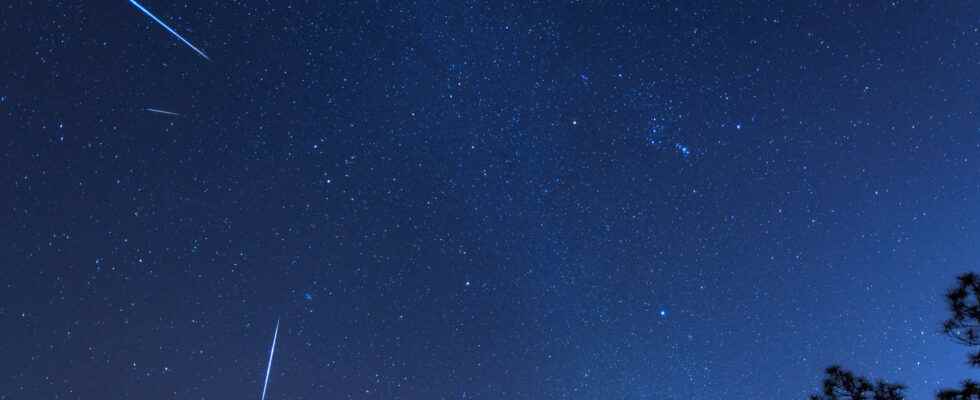December’s beautiful swarm of shooting stars is back. The maximum activity of the Geminids is announced on the night of December 13 to 14, 2022. Here is how to see this meteorite swarm and what is its origin.
It is a shower of shooting stars just as regular and abundant as the famous Perseids in summer: the Geminids make their appearance in the December sky. They are generally active from December 4 to 17, with a peak of activity in the middle of the month.
Where does this swarm come from? Where and when will it be visible in the sky? How to spot it? Here are the answers to these questions.
How to observe them?
This shower of shooting stars is clearly visible from the northern hemisphere of the Earth, then less clearly descending towards the southern hemisphere. In 2022, the Geminids peak on the night of Tuesday December 13 to Wednesday December 14. Under ideal conditions, one can expect to see 100 to 150 meteors per hour.
Usually, ” the main difficulty in observing the Geminids comes from the weather “, according to the indications of Jean-Luc Dauvergne of the French Association of Astronomy. Low temperatures and the risk of rain, which are more frequent in December, can compromise observation.
But, in December 2022, the Moon also risks hindering observation. ” This year, a waning gibbous moon will make seeing most of the swarm more difficult, resulting in only 30-40 meteors visible per hour when it peaks in the northern hemisphere. “says NASA. Nevertheless, not everything should be spoiled by the Moon, because ” the Geminids are so bright the show should still be interesting “.
Let’s remember that ” the orbit of the Geminids is extremely stable (over 10,000 years at least) and therefore the Earth enters the meteoroid cloud every year “, as indicated by the IMCCE (the Institute of Celestial Mechanics and Calculation of Ephemerides) in 2021. As usual with shooting stars, the radiant of the Geminids (the point of the celestial sphere from which the swarm seems to be emerging) is a landmark to observe them, but you can expect to see shooting stars in other places in the sky.
The Geminids appear to originate from the constellation Gemini. It is identified by another well-known constellation: the Big Dipper. With this “big pot”, it is possible to find Castor and Pollux, the two “twin” stars of the constellation. We must look at the distance between the stars Megrez and Merak in the Big Dipper. If one could draw an imaginary line between these two stars, which would continue on the side opposite the handle of the saucepan, it would lead straight to Castor, a star with an orange hue. Pollux is just below.
Geminids move at a speed of 35 km per second, according to NASA. Observed meteors can appear to be moving towards the star Castor no matter where they appear. As the night progresses, shooting stars become faster and shorter. Why ? The Earth moves during the night: it turns towards the constellation of Gemini and the meteors arrive more directly towards the Earth’s atmosphere. In reality, the Geminid meteors all arrive at the same speed: it is our perception that distorts this reality.
Where do the Geminids come from?
The origin of the Geminids seems to come from the asteroid Phaethon, whose strange blue color fascinates scientists. His name is no coincidence: he is baptized as the son of the sun god Helios (in Greek mythology) because of his close orbit to the Sun.
Observed for more than 30 years, Phaeton’s orbit is beginning to be well known to humans (it is estimated today with a margin of error of 40 km). Shortly after the discovery of the asteroid in 1983, the link with the annual Geminid shower, observed since 1861, was established.
Phaeton is an Apollo asteroid, which means that its trajectory intersects Earth’s orbit. As the International Meteor Organization (IMO) explains, Phaeton’s behavior sometimes seems closer to that of a comet: it ” ejects dust as it approaches the Sun. If we can observe the swarm of meteors that Phaeton leaves in its wake around December 14, it is because the Earth is then close to the orbit of the asteroid.
Another notable fact: the activity of the asteroid is asymmetrical. This means that we watch its activity increase slowly until December 14, before falling more rapidly thereafter. In other words, it is better to try to observe the Geminids on the night of December 14 and the preceding ones, rather than the following ones.
You now have all the keys in hand to see the Geminids in December 2022. Happy watching!
